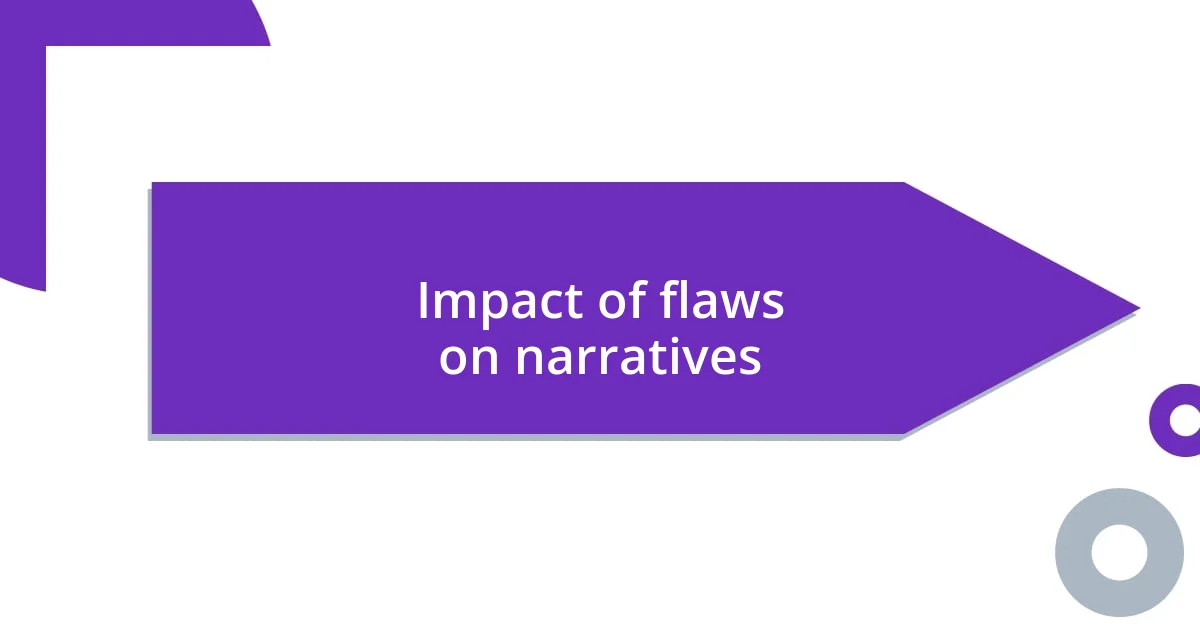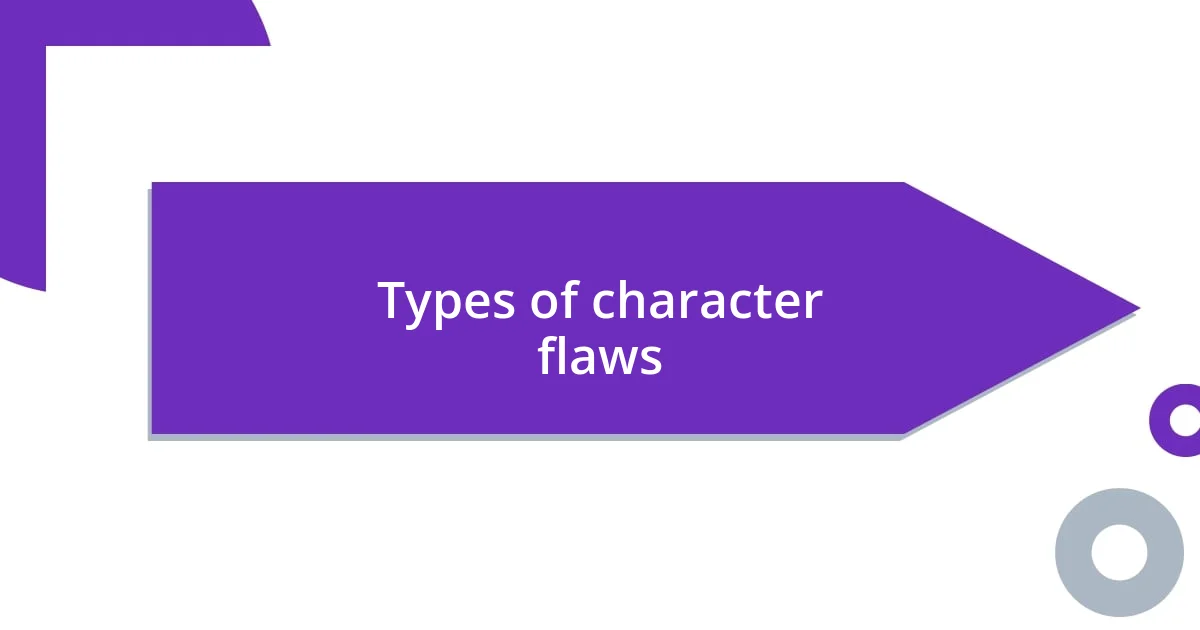Key takeaways:
- Character flaws enhance relatability and drive narratives, highlighting the complexity of human emotions and prompting readers to reflect on their own imperfections.
- Flaws can serve as catalysts for character growth and conflict, leading to compelling story arcs that resonate with personal experiences and foster empathy.
- Successful resolution of flaws often involves personal growth, forgiveness, and self-discovery, underscoring the transformative power of confronting one’s weaknesses.

Understanding character flaws
Character flaws are essential in creating relatable and dynamic characters. I often find myself drawn to stories where characters stumble, misjudge situations, or let their insecurities guide their choices. It makes me reflect on my own imperfections—like when I overthink decisions, wondering if I’m the only one who feels this way. Have you ever felt that way too?
These imperfections not only create tension but also drive the narrative forward. I remember reading a novel about a protagonist whose arrogance led to their downfall. It was painful yet eye-opening, forcing me to consider how our weaknesses can warp our perspectives. This insight hit home when I realized I, too, sometimes allow pride to cloud my judgment.
Flaws can serve as windows into a character’s personality, revealing deeper motivations and fears. Think about a character who struggles with jealousy— their actions can lead to some intense situations that showcase the darker side of human emotion. Reflecting on these moments often makes me wonder: how do our flaws shape our identities? This interplay between imperfection and storytelling is not just compelling; it’s a reminder of our own journeys.

Impact of flaws on narratives
Character flaws profoundly impact narratives by crafting authentic and relatable experiences. When I think back to a film where the leading character harbored a deep-seated fear of vulnerability, it transformed her relationships and ultimately dictated her journey. This fear created a tension that pulled me in; I couldn’t help but empathize with her struggle, as I too have wrestled with the idea of opening up to others.
Additionally, flaws can serve as catalysts for growth, often pushing characters toward self-discovery. I recall a series where the flawed hero started with a heavy burden of guilt from a past failure. Each mistake he encountered along the way was not just a plot point; it became a stepping stone for his evolution. This development highlighted something profound to me: the journey through flawed actions can often lead to redemption and understanding, both for the character and the audience.
Moreover, character flaws can create conflict that keeps readers invested. I once read a story where envy drove a character to sabotage a friend’s opportunities. It wasn’t just the act of sabotage that intrigued me but the internal conflict it sparked. It reminded me of times when envy has crept into my life, leading to difficult choices. Flawed characters help us explore these darker impulses, reflecting the raw reality of human emotions.
| Type of Impact | Description |
|---|---|
| Relatability | Flawed characters often mirror our own imperfections, making them more relatable. |
| Character Development | Flaws can lead to character growth, transforming their journeys into powerful narratives. |
| Conflict Creation | Imperfections can introduce conflict, driving the story and engaging the audience. |

Types of character flaws
I’ve always noticed that character flaws come in various shapes and sizes, each adding its own flavor to the story. Some flaws are deeply rooted, like insecurity or jealousy, while others are more situational, such as impulsiveness or stubbornness. I remember encountering a character whose relentless pride not only strained their relationships but also placed them in perilous situations. It made me reflect on how pride can blind us—and I’ve certainly found myself in similar spots, overlooking the wisdom others might have shared because of my own overconfidence.
Here are some common types of character flaws that often pop up in narratives:
- Insecurity: Characters plagued by self-doubt can create tense situations as they navigate relationships and challenges.
- Arrogance: This can lead to underestimating others and ultimately facing dire consequences.
- Impulsiveness: Making rash decisions often leads to unexpected conflicts, making the journey more thrilling.
- Jealousy: This can drive significant character actions, showcasing the darker aspects of human nature.
- Stubbornness: Refusing to change can create hurdles, both internally and externally, impacting character arcs.
Each type of flaw not only propels the plot but also adds layers of complexity to the characters. For me, encountering these flaws pulls me into a tale, making me ponder my own experiences and choices. How often do I let my insecurities dictate my actions? It’s a question that keeps me engaged long after I’ve closed the book.

Developing flawed characters
When I think about developing flawed characters, I find that layers of complexity can truly bring them to life. For instance, I once crafted a character whose chronic indecision led to a series of missed opportunities. Watching them grapple with fear of failure reminded me of times I’ve hesitated to take risks. Isn’t it fascinating how inaction can be just as damaging as an overt mistake?
Flaws should not only create obstacles but also serve as a mirror for personal reflection. I remember writing about a character whose overbearing need for control spiraled into chaos in their personal relationships. It made me consider my own tendencies; how often do I cling to my plans, only to realize life has its own agenda? Seeing a character navigate the fallout of their flaws elicited a genuine emotional response from me, as it echoed my own struggle for balance between order and spontaneity.
Moreover, intertwining a character’s flaw with their backstory is essential. I once read a book where a woman’s fear of rejection stemmed from past trauma, a detail that profoundly impacted her relationships throughout the narrative. I connected with her journey, as I too have faced fears shaped by earlier experiences. By expanding on those foundational flaws, writers can invite readers to delve deeper into the psyche of the character, making the narrative all the more engaging and relatable.

Flaws and character relatability
When I read about characters grappling with significant flaws, I often find myself reflecting on my own imperfections. Take, for instance, a character whose impulsiveness lands them in trouble time and again. It reminds me of a time when I jumped into a decision without thinking it through, only to realize later that my hasty choice led to unexpected challenges. It’s these relatable moments that draw me into the narrative and make me empathize with the character’s journey.
Character flaws can serve as bridges between the fictional world and our own. For example, I encountered a protagonist whose jealousy drove a wedge between them and their closest friends. Watching them react out of insecurity and shame made me think about my own experiences with envy and how it has clouded my perceptions in the past. Doesn’t it strike you how quickly we might project our fears onto others? In my experience, such relatable traits create a bond between the reader and the character, inviting introspection.
What really strikes me is how these flaws reveal the characters’ vulnerabilities. I remember reading about a character whose stubbornness led them to push away loved ones. Each moment of conflict felt painfully relatable; it took me back to times when I was too proud to admit my mistakes or ask for help. I often wonder, how many relationships are strained by our unwillingness to change? This connection to flawed characters allows us to not only relate to their struggles but also to question our own behaviors, making the narrative even more impactful.

Resolution of character flaws
When it comes to the resolution of character flaws, I’m always struck by how these arcs can transform a story. I remember a character I created who obsessively needed validation from others. Gradually, they learned to trust their self-worth, and it was incredible to watch them challenge their assumptions about love and acceptance. Hasn’t there been a moment in your life where you had to redefine your sense of self? It’s often those turning points that resonate most deeply with readers.
The path to resolving flaws is rarely straightforward. I think about a protagonist in a novel I recently read who struggled with deep-seated fear of commitment. Their journey involved messy mistakes and heartbreaks, but eventually, they confronted their fears by confronting a significant past trauma. I felt an ache in my chest during those scenes because it mirrored my own journey of navigating relationships carefully, trying not to repeat past mistakes. Don’t we all carry some baggage that can warp our perceptions of what love truly is?
Resolution often requires forgiveness—both from others and oneself. I clearly remember writing a character who had wronged a friend due to their pride. Watching them apologize and take steps to heal the relationship filled me with hope. It made me reflect on my own life and the times I had to swallow my pride to make amends. Isn’t it powerful when characters demonstrate that growth isn’t just possible, but necessary? That journey can inspire us to tackle our own flaws, showing the impact of transformation on both the character and the relationships around them.

Examples from popular narratives
One of my favorite examples of character flaws comes from Jay Gatsby in “The Great Gatsby.” His relentless pursuit of Daisy Buchanan, fueled by idealism and unyielding hope, spirals into obsession. I often think about how our dreams can cloud our judgment—haven’t you ever chased something to the point of losing sight of reality? Gatsby’s tragic end reminds us that while ambition is admirable, it can also be deeply flawed when it blinds us to the truth.
In “Harry Potter and the Order of the Phoenix,” we see a significant portrayal of anger through Harry. His internal struggle and the way his temper flares often resonate with me; I recall moments when my own frustrations led to situations I later regretted. Isn’t it cathartic to witness a character wrestle with their emotions? I believe it teaches us that anger, while a natural response, must be managed to avoid estranging those we care about.
Similarly, Elizabeth Bennet from “Pride and Prejudice” exemplifies the flaw of prejudice. Initially, she misjudges Mr. Darcy, allowing her biases to shape her perceptions. Reflecting on that, I’ve found myself jumping to conclusions about people before knowing their true story. Don’t we all have our blind spots? It’s through Elizabeth’s journey that we learn the value of humility and the importance of looking beyond first impressions, enriching our understanding of character and human nature.














